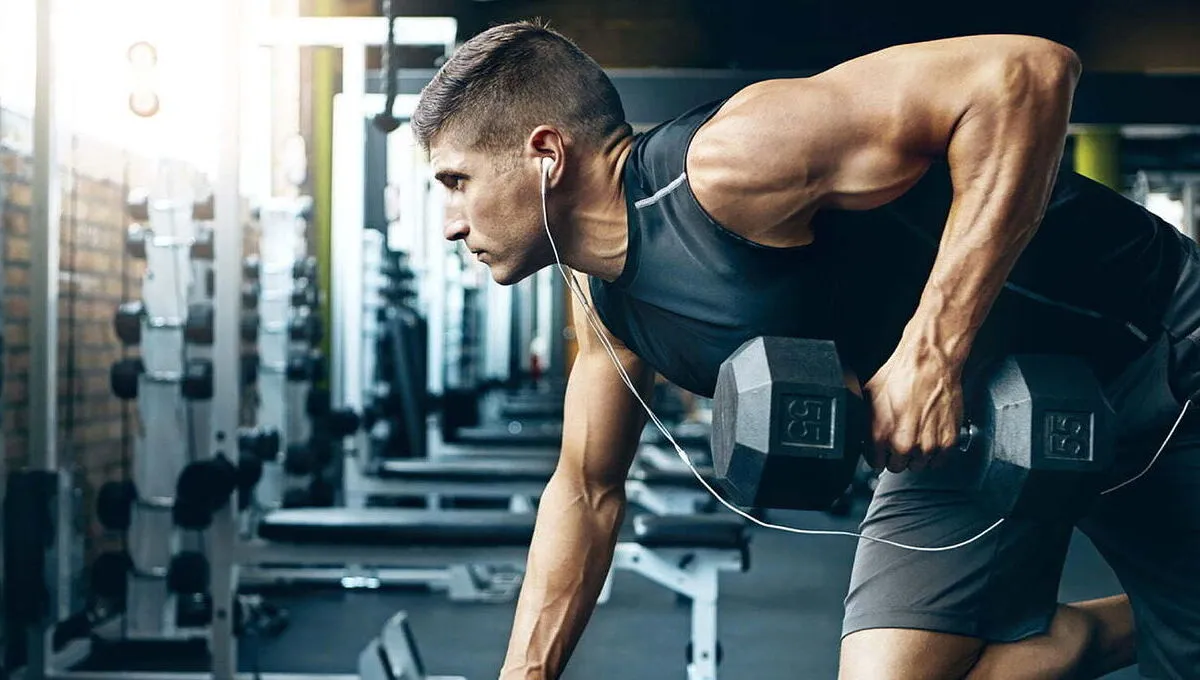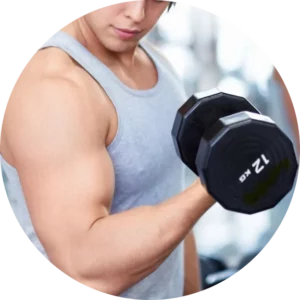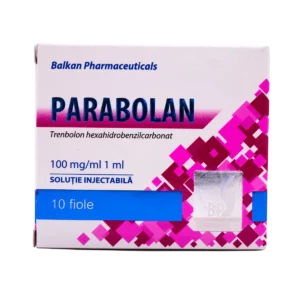Read the main article: How to make a training program
Exercises are divided into 4 categories. Choose from them those exercises that are appropriate for the purpose of your program.
Main exercises: “Big” exercises with free weights that work on several muscle groups and joints, preferably in several planes, fall into this category. They allow you to use the maximum weight for the target muscle group and most of all load both the body and the nervous system.
Additional exercises: The same as the main ones, but with less stress on the body and central nervous system.
Auxiliary exercises: This group includes a large number of various isolating exercises and most exercises on simulators. Due to the simplification of movement and weight loss, the nervous system strains less.
Corrective exercises: These are exercises to correct an imbalance in muscle development or to tighten weaknesses. For example, exercises for the rotator cuff of the shoulder fall into this group.
As a rule, in bodybuilding for one muscle group is performed: 1 main exercise and 2-3 additional or auxiliary.
Quadriceps exercises
The main ones:
- Weightlifting squats with a barbell on the back (legs shoulder width apart, minimal body inclination).
- Powerlifting squats with a barbell on the back (wide stance, tilt more).
- Powerlifting squats with a barbell on the chest.
Additional ones:
- A variety of lunges.
- Squatting in scissors.
- Leg press.
- Hack barbell squats.
- Squats with dumbbells.
Auxiliary ones:
- Hack squats in the simulator.
- A variety of climbs on the step.
- Leg extension.
- Sissy Squats.
Corrective ones:
- Leg extension with a tourniquet.
Biceps / Thigh / Glute Exercise
The main ones:
- Romanian deadlift.
- Deadlift on straight legs.
- Sumo deadlift.
- Deadlift with jerk (wide) grip.
Additional ones:
- Slopes with a barbell on the shoulders.
Auxiliary ones:
- Reverse hyperextension.
- Bending the legs.
Corrective ones:
- Bending the legs on a Swiss ball.
- Bending the legs with a rubber band.
Chest Exercise
Read also: Chest muscles – exercises and training features
The main ones:
- Bench press.
- Bench press on an incline bench head up.
- “Chest” push-ups on the uneven bars.
Additional ones:
- Bench press on an incline bench head down.
- Bench press dumbbell.
- Bench press to the neck.
Auxiliary ones:
- Side raise of hands on blocks.
- Dumbbells fly.
- Exercise machines for side raises.
- Exercise machines for presses on the chest muscles.
Corrective ones:
- Push-ups on a Swiss ball.
Exercises for the upper back and back bundles of the deltoid muscles
Read also: Back – exercises and training features
The main ones:
- Various options for pull-ups.
- Bent-over row.
- Bent-over row with support chest.
- T-bar (Hip) thrusts.
Additional ones:
- Dumbbell bent-over row.
- Lat pull-down of upper and lower blocks.
- Pull-ups on the low bar.
Auxiliary ones:
- Push-ups of the upper block with straight arms.
- Pull-over of the block.
- Traction on the exercise machines.
- Dumbbell bent in the slope.
Corrective ones:
- Shrugs with dumbbells on the bench.
- Shrugs (mixing of the shoulder blades) on the blocks sitting.
Shoulder exercises
Read also: Shoulders – exercises and training features
The main ones:
- Lifting the barbell to the chest.
- Bench press.
- Overhead press.
- Clean and jerk.
- Sitting overhead press.
Additional ones:
- Sitting dumbbell bench presses.
- Standing dumbbell bench presses.
- Arnold’s bench press.
- Wide grip bench press.
Auxiliary ones:
- Presses for deltas on exercise machines.
- Rises through the sides.
- Rises forward.
Corrective ones:
- Cuban bench press.
- Shoulder rotation outward.
Arm curl exercises (biceps, brachialis)
Read also: Biceps – exercises and training features
The main ones:
- Biceps curls with a barbell.
- Biceps curls with a barbell on Scott’s bench.
Additional ones:
- Biceps curls with dumbbells.
- Hammer flexion with dumbbells.
- Dumbbell flexions on Scott’s bench.
- Reverse grip bends.
- Zottman’s biceps curls.
Auxiliary ones:
- Biceps curls on the simulators.
- Biceps curls on blocks.
Corrective ones:
- Bending the arm with a hammer with turning the wrist (supination).
Triceps Exercises
Read also: Triceps – exercises and training features
The main ones:
- Bench press with a narrow grip.
- Bench press with a narrow grip, lying on an incline with head down.
- “Triceps” push-ups on the uneven bars.
Additional ones:
- Bench press with a narrow grip, lying on an incline with head up.
- Bench press with reverse grip.
- Triceps curls with a barbell in lying position.
- Triceps curls with dumbbells in lying position.
Auxiliary ones:
- Triceps curls with dumbbells in standing position.
- Triceps curls with a barbell in standing position.
- Triceps curls on blocks and on simulators.
Corrective ones:
- Narrow push-ups on a Swiss ball.
How to choose the right exercise
Of course, this is not a complete list of all the exercises that you can do, but just a sample to begin with to understand the idea. If your goal is strength, stop at the main and additional exercises: they give the greatest increase in strength. You can do two main exercises in training, but I do not recommend it, because the load on the central nervous system will be too great. One main and one additional work better.
The disadvantage of these multi-joint exercises is that they do not really tighten weaknesses. When you lift a decent weight by working with several large muscle groups, the body tries to do this in an optimal way, shifting the load on those muscles that are stronger.
A classic example is the bench press: if you have strong shoulders, the bench press will not help you pump up the pectoral, since the body will bear most of the load on the deltas and triceps, leaving weak pectoral muscles without the necessary stimulus.
So, if the goal of your workouts is to build harmoniously developed muscles, you may need to include a variety of supporting exercises that develop weak areas. In this case, one main or one additional exercise should always be present in the program.
Before you start, be sure to read the article: The number of exercises per muscle group
| Goal | 1 exercise per muscle group | 2 exercises per muscle group | 3 exercises per muscle group (most often) | 4 exercises per muscle group |
| Strength | 1 main | 1 main+1 additional | ||
| 1 main+1 main | ||||
| Muscle Mass | 1 main+1 additional | 1 main + 1 additional + 1 auxiliary | Same as with three, with the addition of one auxiliary or corrective | |
| 1 main+1 auxiliary | 1 main + 2 additional | |||
| 1 additional+1 auxiliary | 1 additional+2 auxiliary | |||
| 2 additional+1 auxiliary |
If you are working on a strength program and you have a problem with some small muscle group, for example, a weak rotating cuff of the shoulder, then calmly add a corrective exercise, not taking into account the program, since its intensity is low.
It is very important to avoid overlapping when choosing exercises. The restorative abilities of your body are limited, so it’s just stupid to spend them on a duplicate load. Overlapping exercises are similar movements on one muscle group, with a similar grip or stance. For example, the bench press in lying on a horizontal bench, the bench press dumbbells lying on a horizontal bench and the bench press lying on Smith’s simulator are slightly different variations of one exercise. The same, for example, with biceps curls with a barbell, biceps curls with dumbbells with supinated grip (palms up) or on the block. So when you choose exercises for one muscle group, take those that complement, rather than copy, each other.
One final note: avoid overloading non-target muscles. Often I come across such programs for feet:
- Squats
- Tilt with a barbell on the shoulders
- Front squats
- Romanian deadlift with dumbbells
- Leg extension
- Reverse hyperextension
At first glance, everything seems to be in order, good exercises for the muscles of the anterior and posterior thighs were selected. And yet this is an unsuccessful combination. Why? Because almost all of these exercises, apart from leg extensions, significantly load the lower back.
Of course, there is nothing wrong with a strong lower back. But imagine in what condition the back straighteners will be after squats and bends. Completely exhausted; and you will not be able to qualitatively do the subsequent exercises. You will not be able to keep the body upright for front squats, the Romanian deadlift and reverse hyperextensions will be done somehow, because the main working muscles will be fatally worn out.
So be smarter and combine exercises in such a way that the overlap is minimal and you can work efficiently throughout the workout.







